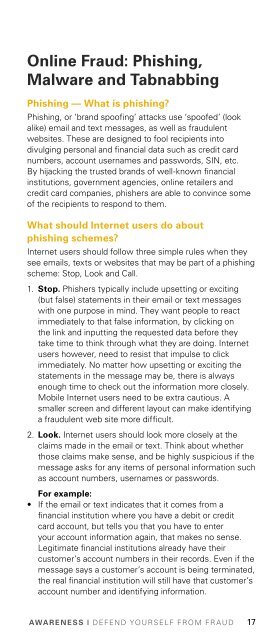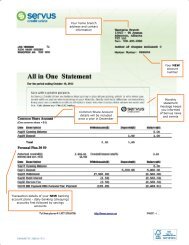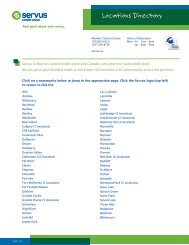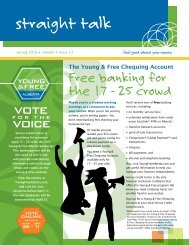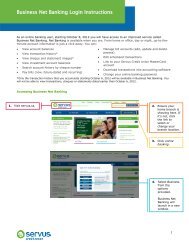Fraud Awareness Booklet - Servus Credit Union
Fraud Awareness Booklet - Servus Credit Union
Fraud Awareness Booklet - Servus Credit Union
You also want an ePaper? Increase the reach of your titles
YUMPU automatically turns print PDFs into web optimized ePapers that Google loves.
Online <strong>Fraud</strong>: Phishing,Malware and TabnabbingPhishing — What is phishing?Phishing, or ‘brand spoofing’ attacks use ‘spoofed’ (lookalike) email and text messages, as well as fraudulentwebsites. These are designed to fool recipients intodivulging personal and financial data such as credit cardnumbers, account usernames and passwords, SIN, etc.By hijacking the trusted brands of well-known financialinstitutions, government agencies, online retailers andcredit card companies, phishers are able to convince someof the recipients to respond to them.What should Internet users do aboutphishing schemes?Internet users should follow three simple rules when theysee emails, texts or websites that may be part of a phishingscheme: Stop, Look and Call.1. Stop. Phishers typically include upsetting or exciting(but false) statements in their email or text messageswith one purpose in mind. They want people to reactimmediately to that false information, by clicking onthe link and inputting the requested data before theytake time to think through what they are doing. Internetusers however, need to resist that impulse to clickimmediately. No matter how upsetting or exciting thestatements in the message may be, there is alwaysenough time to check out the information more closely.Mobile Internet users need to be extra cautious. Asmaller screen and different layout can make identifyinga fraudulent web site more difficult.2. Look. Internet users should look more closely at theclaims made in the email or text. Think about whetherthose claims make sense, and be highly suspicious if themessage asks for any items of personal information suchas account numbers, usernames or passwords.For example:• If the email or text indicates that it comes from afinancial institution where you have a debit or creditcard account, but tells you that you have to enteryour account information again, that makes no sense.Legitimate financial institutions already have theircustomer’s account numbers in their records. Even if themessage says a customer’s account is being terminated,the real financial institution will still have that customer’saccount number and identifying information.AWARENESS | DEFEND YOURSELF FROM FRAUD 17


